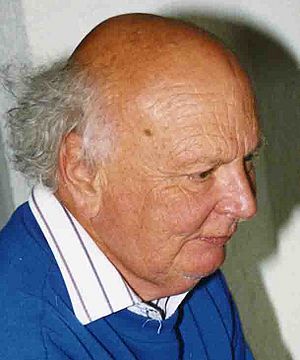Conway Berners-Lee facts for kids
Quick facts for kids
Conway Berners-Lee
|
|
|---|---|
 |
|
| Born |
Conway Maurice Berners-Lee
19 September 1921 Birmingham, England
|
| Died | 1 February 2019 (aged 97) |
| Alma mater | Trinity College, Cambridge |
| Employer | NPL ICI, Ferranti, ICT, ICL |
| Spouse(s) | |
| Children | Tim Peter Helen Mike |
| Parent(s) | Helen Lane Campbell Gray and Cecil Burford Berners-Lee |
Conway Maurice Berners-Lee (born September 19, 1921 – died February 1, 2019) was an English mathematician and computer scientist. He was a key part of the team that created the Ferranti Mark 1. This was the world's first computer that could store programs and was sold to businesses.
Conway was born in Birmingham, England. He was the father of two famous people. His son, Sir Tim Berners-Lee, invented the World Wide Web. His other son, Professor Mike Berners-Lee, studies climate change.
Contents
Early Life and Family
Conway Berners-Lee was the son of Major Cecil Burford Berners-Lee and Helen Lane Campbell Gray. His mother was from Winnipeg, Manitoba, Canada.
Conway Berners-Lee passed away in February 2019. He was 97 years old.
Conway's Career in Computing
Starting in World War II
When World War II began, Conway was studying mathematics at Trinity College, Cambridge. He wanted to join the armed forces. However, the government asked him to keep studying. They needed people trained in math and electronics. He also took special classes in electronics.
After university, he joined the army's Corps of Royal Electrical and Mechanical Engineers (REME). He worked on Radar systems. These systems helped aim guns and searchlights in England.
Working with Punched Cards
After the war, Conway was sent to Egypt. There, he learned about statistics. He joined the Number 1 Statistics Unit of the Royal Army Ordnance Corps. His job was to close down a huge system that used punched cards. These cards stored information, like details for five million vehicles.
He had to get rid of 30 women who had been punching these cards. His last big task was to sort 250,000 personnel cards. The goal was to get all service members onto ships to go home. There was a race between his machines and clerks doing the job by hand. The clerks actually won!
Joining Ferranti
Conway left the army in 1947. He then worked with punched card systems for Imperial Chemical Industries (ICI). In 1952, he met his future wife, Mary Lee Woods, at a Christmas party. She was a programmer for the Ferranti Mark 1 computers.
Conway joined Ferranti in 1953. He worked at their London Computer Centre. He and Mary were married on July 10, 1954.
Computers for Business
In the 1950s, people weren't sure how computers could be used outside of math. Conway was good at finding new ways to use them. He helped create programs for basic data processing. This included sorting and updating files.
In 1956, he designed a program to plan how to make products from different parts. For example, it could plan how to make animal feed. In 1957, he wrote an article about how to load machines efficiently. A report he made in 1964 listed 31 projects. These projects used his ideas to help many different businesses.
Company Changes and New Ideas
Ferranti's computer division joined with International Computers and Tabulators (ICT) in 1963. Then, ICT joined with other companies in 1968 to form International Computers Limited (ICL).
In 1960, Conway developed a way to edit text for printing. This included how to hyphenate words. Computer memory was very expensive back then. So, he also created a way to make text smaller, or compress it. He shared this idea in 1963.
In the late 1960s, Conway led a team at ICL that worked on medical uses for computers. His text compression ideas were used in an early system for electronic patient records.
Later Career and Retirement
In the 1970s, Conway worked on a special model for ICL's new computers. This model was called FAST. It helped predict how well the computers would perform. It was like a "Football Analogy for System Throughput." He retired in 1986.


